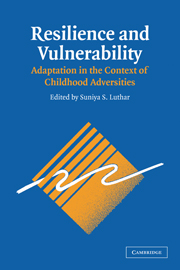Book contents
- Frontmatter
- Contents
- List of Contributors
- Foreword by Dante Cicchetti
- Preface
- 1 A Resilience Framework for Research, Policy, and Practice
- PART I FAMILIAL ADVERSITIES: PARENTAL PSYCHOPATHOLOGY AND FAMILY PROCESSES
- PART II EXOSYSTEMIC AND SOCIODEMOGRAPHIC RISKS
- 10 Rethinking Resilience: A Developmental Process Perspective
- 11 Poverty and Early Childhood Adjustment
- 12 Emerging Perspectives on Context Specificity of Children's Adaptation and Resilience: Evidence from a Decade of Research with Urban Children in Adversity
- 13 Holistic Contextual Perspectives on Risk, Protection, and Competence among Low-Income Urban Adolescents
- 14 Overcoming the Odds? Adolescent Development in the Context of Urban Poverty
- 15 Adaptation among Youth Facing Multiple Risks: Prospective Research Findings
- 16 Positive Adaptation among Youth Exposed to Community Violence
- 17 Perceived Discrimination and Resilience
- 18 Promoting Resilience through Early Childhood Intervention
- PART III COMMENTARIES
- Index
- References
18 - Promoting Resilience through Early Childhood Intervention
Published online by Cambridge University Press: 05 June 2012
- Frontmatter
- Contents
- List of Contributors
- Foreword by Dante Cicchetti
- Preface
- 1 A Resilience Framework for Research, Policy, and Practice
- PART I FAMILIAL ADVERSITIES: PARENTAL PSYCHOPATHOLOGY AND FAMILY PROCESSES
- PART II EXOSYSTEMIC AND SOCIODEMOGRAPHIC RISKS
- 10 Rethinking Resilience: A Developmental Process Perspective
- 11 Poverty and Early Childhood Adjustment
- 12 Emerging Perspectives on Context Specificity of Children's Adaptation and Resilience: Evidence from a Decade of Research with Urban Children in Adversity
- 13 Holistic Contextual Perspectives on Risk, Protection, and Competence among Low-Income Urban Adolescents
- 14 Overcoming the Odds? Adolescent Development in the Context of Urban Poverty
- 15 Adaptation among Youth Facing Multiple Risks: Prospective Research Findings
- 16 Positive Adaptation among Youth Exposed to Community Violence
- 17 Perceived Discrimination and Resilience
- 18 Promoting Resilience through Early Childhood Intervention
- PART III COMMENTARIES
- Index
- References
Summary
INTRODUCTION
In the past decade, research on resilience has grown dramatically beyond the field of clinical psychology from which it arose. Applications in education, social work, human development, health, and business have expanded the conceptualization of resilience from a psychosocial perspective to a multidimensional one (Wang & Gordon, 1994; Werner & Smith, 1992; Zimmerman & Arunkumar, 1994). Although much of the knowledge base has highlighted measurement and methodology, a major source of the appeal of the resilience concept is to enhance the well-being of individuals through social programs and policies. One major priority is the identification of personal and environmental factors that promote successful adjustment among the most vulnerable young people.
In this chapter, we review evidence about the effects of early childhood interventions in promoting resilience for children who have experienced high levels of social-environmental risk due to economic disadvantage. We address several contemporary issues including the measurement of resilience, interventions as protective factors, and the pathways through which the effects of interventions lead to positive developmental outcomes.
Despite continuing concerns about construct and measurement validity (Luthar, Cicchetti, & Becker, 2000; Tolan, 1996), resilience as a subject of investigation has been a major influence on developmental research. Four characteristics explain its influence. First, resilience is a positive outcome of development and thus provides an alternative perspective to dysfunctional behavior that has long been associated with the field of psychology. Undue focus on individual pathology and disease can have stigmatizing effects, and this is largely avoided with resilience.
- Type
- Chapter
- Information
- Resilience and VulnerabilityAdaptation in the Context of Childhood Adversities, pp. 436 - 460Publisher: Cambridge University PressPrint publication year: 2003
References
- 15
- Cited by



